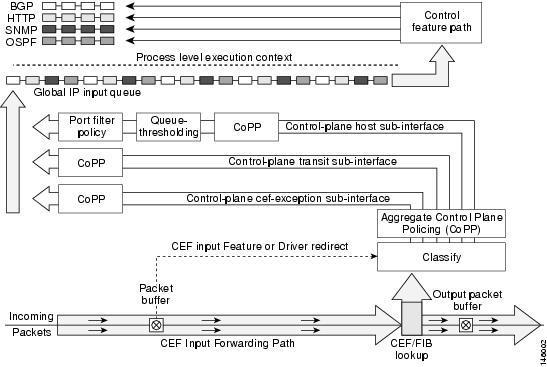Difference between revisions of "Netband Project - CoPP"
From Teknologisk videncenter
(→Port-filter policy) |
(→Configuration) |
||
| Line 28: | Line 28: | ||
==Configuration== | ==Configuration== | ||
| − | <pre>Versions prior to 12.4(4)T or if you only want to configure the aggregate interface | + | <pre>Control plane Policing |
| + | Versions prior to 12.4(4)T or if you only want to configure the aggregate interface | ||
ip access-list extended coppacl-igp | ip access-list extended coppacl-igp | ||
Revision as of 07:34, 16 April 2009
<accesscontrol>NetBand</accesscontrol> This page is part of the Netband Project
Contents
Control Plane Policing
- The Control Plane Policing feature allows users to configure a quality of service (QoS) filter that manages the traffic flow of control plane packets to protect the control plane of Cisco IOS routers and switches against reconnaissance and denial-of-service (DoS) attacks.
- CoPP can help maintain packet forwarding and protocol states despite an attack or heavy traffic load on the router or switch.
- Uses MQC (Modular QoS CLI)
- In version 12.4(4)T additional features were introduced
Control Plane Protection
- Introduces subinterfaces to the control plane(12.4(4)T)
- Aggregrate Control Plane Policing
- Control Plane cef-exception subinterface
- receives all traffic that is either redirected as a result of a configured input feature in the CEF packet forwarding path for process switching or directly enqueued in the control plane input queue by the interface driver.
- Eg. ARP, L2 Keepalives and all non-IP host traffic.
- Control Plane host subinterface
- receives all control-plane IP traffic that is directly destined for one of the router interfaces.
- All host traffic terminates on and is processed by the router.
- Eg. SSH, SNMP, BGP, OSPF, Tunnel termination and EIGRP.
- Control Plane transit subinterface
- receives all control-plane IP traffic that is software switched by the route processor.
- Control Plane cef-exception subinterface
Port-filter policy
- blocks traffic destined to closed or nonlistened TCP/UDP ports
- Only works with the host subinterface.
- maintains a global database of all open TCP and UDP ports on the router, including ports created by applications.
Configuration
Control plane Policing Versions prior to 12.4(4)T or if you only want to configure the aggregate interface ip access-list extended coppacl-igp permit ospf any host 224.0.0.5 permit ospf any host 224.0.0.6 permit ospf any any ! ip access-list extended coppacl-management permit tcp 10.0.0.0 0.255.255.255 any eq 22 permit tcp 10.0.0.0 0.255.255.255 any eq telnet permit udp host 10.1.1.10 any eq snmp permit udp host 10.0.0.11 any eq ntp ! ip access-list extended coppacl-monitoring permit icmp any any ttl-exceeded permit icmp any any port-unreachable permit icmp any any echo-reply permit icmp any any echo ! ip access-list extended coppacl-critical-app permit udp host 0.0.0.0 host 255.255.255.255 eq bootps permit udp host 10.1.1.11 eq bootps any eq bootps ! class-map match-all coppclass-igp match access-group name coppacl-igp class-map match-all coppclass-management match access-group name coppacl-management class-map match-all coppclass-monitoring match access-group name coppacl-monitoring class-map match-all coppclass-critical-app match access-group name coppacl-critical-app class-map match-all coppclass-layer2 match protocol arp ! policy-map copp-policy class coppclass-igp class coppclass-management police rate 250 pps conform-action transmit exceed-action drop class coppclass-monitoring police rate 50 pps conform-action transmit exceed-action drop class coppclass-critical-app police rate 75 pps conform-action transmit exceed-action drop class coppclass-layer2 police rate 25 pps conform-action transmit exceed-action drop class class-default police rate 10 pps conform-action transmit exceed-action drop ! control-plane service-policy input copp-policy
External Links
Prior to 12.4(4)T
CoPP
12.4(4)T and forward
CoP extended feature set
CoPP best practice design guide
